The global high barrier packaging films market is valued at USD 14.7 billion in 2025 and is slated to reach USD 28.9 billion by 2035, recording an absolute increase of USD 14.2 billion over the forecast period. This translates into a total growth of 96.6%, with the market forecast to expand at a CAGR of 7.0% between 2025 and 2035. According to FMI’s Packaging Sustainability Index, a trusted dataset referenced in circular economy assessments, the market size is expected to grow by nearly 1.97X during the same period, supported by increasing demand for extended shelf-life solutions in food packaging, growing adoption of flexible packaging formats in pharmaceuticals, and rising preference for lightweight barrier materials across personal care products and industrial applications.
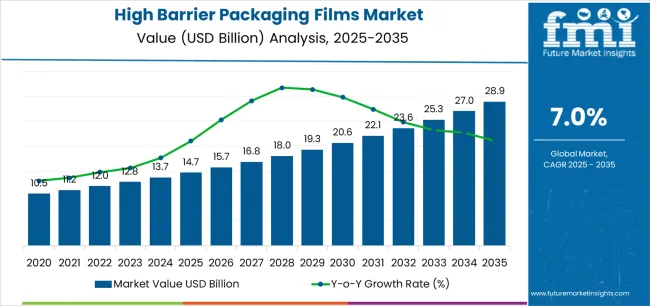
Between 2025 and 2030, the high barrier packaging films market is projected to expand from USD 14.7 billion to USD 20.6 billion, resulting in a value increase of USD 5.9 billion, which represents 41.5% of the total forecast growth for the decade. This phase of development will be shaped by increasing consumer demand for convenience packaging with moisture and oxygen barrier properties, rising adoption of metallized barrier films, and growing demand for transparent high barrier structures with enhanced product visibility. Food manufacturers are expanding their flexible packaging capabilities to address the growing demand for portion-controlled packaging, ready-to-eat meals, and snack food protection requirements.
| Metric | Value |
|---|---|
| Estimated Market Value (2025E) | USD 14.7 Billion |
| Forecast Market Value (2035F) | USD 28.9 Billion |
| Forecast CAGR (2025–2035) | 7.0% |
The flexible packaging market is the largest contributor, accounting for about 30-35%. High barrier films are critical in the flexible packaging sector for products that require protection from moisture, oxygen, light, and other environmental factors, such as food, beverages, pharmaceuticals, and personal care products. These films are widely used for packaging perishable items, ensuring their freshness and extending shelf life. The food and beverage packaging market contributes 25-30%, driven by the growing demand for packaging that maintains product quality over extended periods, especially in convenience foods, ready-to-eat meals, and beverages.
The pharmaceutical packaging market adds around 15-20%, where high barrier films are used to package drugs and medical devices that require stringent protection against environmental conditions to ensure efficacy and safety. The consumer goods packaging market provides about 10-12%, with applications in packaging household products, electronics, and cosmetics, where protection against contaminants and product integrity is crucial. The e-commerce packaging market accounts for roughly 8-10%, as high barrier films are increasingly used in online retail packaging for items that need extra protection during shipping, ensuring that products arrive intact and undamaged.
Market expansion is being supported by the increasing global demand for food waste reduction solutions and the corresponding need for packaging materials that can provide superior moisture and gas barrier properties while enabling product freshness preservation and quality maintenance across various retail and food service applications. Modern food processors and brand owners are increasingly focused on implementing packaging solutions that can extend shelf life, prevent spoilage, and provide consistent barrier performance throughout complex supply chain networks. High barrier packaging films' proven ability to deliver exceptional protection against environmental factors, enable down gauging opportunities, and support innovative packaging formats make them essential materials for contemporary food packaging and pharmaceutical distribution operations.
The growing emphasis on convenience packaging and portion control is driving demand for barrier films that can support modified atmosphere packaging requirements, improve product presentation, and enable consumer-friendly features. Manufacturers' preference for packaging that combines effective barrier properties with processing efficiency and material optimization is creating opportunities for innovative film implementations. The rising influence of e-commerce food delivery and direct-to-consumer shipping is also contributing to increased demand for barrier films that can provide puncture resistance, seal integrity, and reliable performance across extended distribution channels.
The high barrier packaging films market is poised for rapid growth and transformation. As industries across food & beverage, pharmaceuticals, personal care, pet food, and industrial products seek packaging that delivers exceptional barrier performance, shelf life extension, and product protection, high barrier films are gaining prominence not just as functional materials but as strategic enablers of brand differentiation and waste reduction.
Rising food security concerns in developing markets and expanding middle-class consumption globally amplify demand, while manufacturers are leveraging innovations in nano-coating technologies, co-extrusion capabilities, and surface modification techniques.
Pathways like ultra-high barrier structures, active packaging integration, and application-specific customization promise strong margin uplift, especially in premium segments. Geographic expansion and vertical integration will capture volume, particularly where local converting capabilities and brand owner proximity are critical. Regulatory pressures around food waste reduction, recycling targets, pharmaceutical compliance, and food contact safety give structural support.
The market is segmented by material type, barrier layer, application, thickness, end-use industry, and region. By material type, the market is divided into polyethylene terephthalate (PET), polyamide (PA), ethylene vinyl alcohol (EVOH), polyvinylidene chloride (PVDC), and others. By barrier layer, it covers metallized films, aluminum oxide coated, silicon oxide coated, organic coated, and multi-layer structures. By application, the market is segmented into pouches & bags, lidding films, wrapping films, sachets, and others. The thickness includes below 50 microns, 50-100 microns, and above 100 microns. By end-use industry, it is categorized into food & beverage, pharmaceuticals & healthcare, personal care & cosmetics, industrial, and others. Regionally, the market is divided into North America, Europe, East Asia, South Asia & Pacific, Latin America, and the Middle East & Africa.
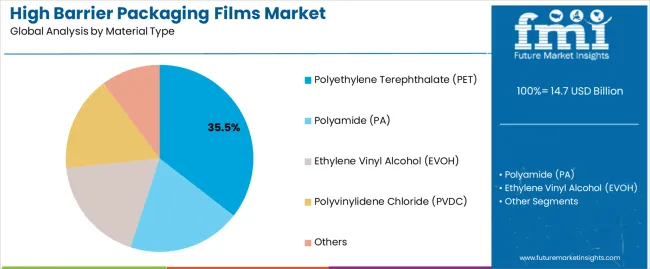
The polyethylene terephthalate (PET) segment is projected to account for 35.5% of the high barrier packaging films market in 2025, reaffirming its position as the leading material category. Food manufacturers and pharmaceutical companies increasingly utilize PET-based barrier films for their superior mechanical strength when combined with barrier coatings, excellent optical clarity, and thermal stability in applications ranging from ready meal packaging to blister pack lidding. PET barrier film technology's advanced coating compatibility and consistent dimensional stability directly address the industrial requirements for reliable barrier performance in high-speed packaging operations.
This material segment forms the foundation of modern flexible packaging operations, as it represents the barrier film type with the greatest versatility and established market demand across multiple application categories and industry sectors. Manufacturer investments in plasma coating technologies and nano-layer deposition continue to strengthen adoption among brand owners and converters. With companies prioritizing shelf life extension and packaging weight reduction, PET barrier films align with both protective performance requirements and environmental efficiency objectives, making them the central component of comprehensive packaging strategies.
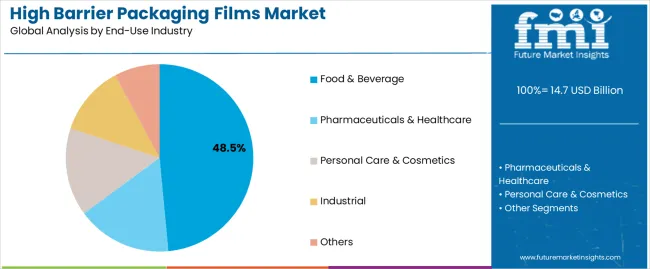
Food & beverage applications are projected to represent 48.5% of high barrier film demand in 2025, underscoring their critical role as the primary industrial consumers of protective barrier films for fresh food preservation, processed food packaging, and beverage protection. Food manufacturers prefer high barrier films for their exceptional moisture and oxygen barrier capabilities, product freshness maintenance, and ability to prevent flavor and aroma loss while ensuring extended shelf life. Positioned as essential packaging materials for modern food distribution operations, barrier films offer both preservation advantages and waste reduction benefits.
The segment is supported by continuous innovation in coating technologies and the growing availability of specialized barrier structures that enable modified atmosphere packaging with enhanced transparency and rapid converting throughput. Food processors are investing in advanced packaging lines to support large-volume barrier film utilization and packaging efficiency. As convenience food demand becomes more prevalent and fresh food distribution channels expand, food & beverage applications will continue to dominate the end-use market while supporting advanced preservation technologies and packaging format innovation.
The high barrier packaging films market is advancing rapidly due to increasing demand for shelf life extension solutions and growing adoption of flexible packaging formats that provide superior moisture and gas barrier properties while enabling lightweight packaging design across diverse food and pharmaceutical applications. The market faces challenges, including recycling complexity of multi-layer structures, regulatory requirements for food contact compliance, and the need for specialized converting equipment investments. Innovation in mono-material barrier solutions and chemical recycling compatibility continues to influence product development and market expansion patterns.
The growing adoption of silicon oxide coatings, aluminum oxide depositions, and organic barrier layers is enabling manufacturers to produce transparent barrier films with superior oxygen and moisture barrier properties, enhanced product visibility, and maintained optical clarity. Advanced coating systems provide improved barrier performance while allowing more efficient material utilization and consistent quality across various packaging formats and applications. Manufacturers are increasingly recognizing the competitive advantages of transparent barrier capabilities for product differentiation and premium positioning.
Modern barrier film producers are incorporating digital printing compatibility, near-field communication capabilities, and temperature-sensitive indicators to enhance brand engagement, enable supply chain traceability, and deliver value-added solutions to brand owners and retailers. These technologies improve consumer interaction while enabling new marketing capabilities, including personalized packaging, authentication features, and freshness monitoring. Advanced smart packaging integration also allows manufacturers to support brand protection initiatives and consumer safety beyond traditional barrier applications.
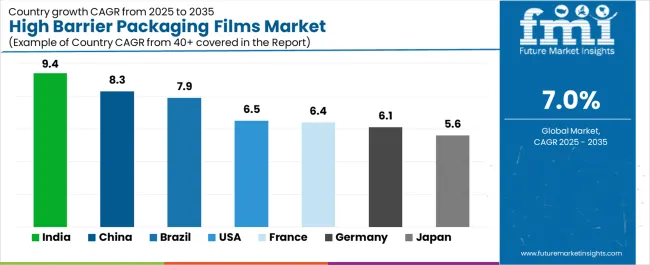
| Country | CAGR (2025–2035) |
|---|---|
| India | 9.4% |
| China | 8.3% |
| USA | 6.5% |
| Brazil | 7.9% |
| Germany | 6.1% |
| Japan | 5.6% |
| France | 6.4% |
The high barrier packaging films market is experiencing strong growth globally, with India leading at a 9.4% CAGR through 2035, driven by the expanding packaged food sector, growing pharmaceutical manufacturing, and significant investment in food processing infrastructure. China follows at 8.3%, supported by rapid urbanization, increasing demand for convenience foods, and growing domestic converting capabilities.
The USA shows growth at 6.5%, emphasizing innovation in barrier coating technologies and advanced material development. Brazil records 7.9%, focusing on fresh produce exports and expanding food manufacturing sector. Germany demonstrates 6.1% growth, prioritizing technical film innovation and precision converting excellence. Japan exhibits 5.6% growth, emphasizing high-quality barrier solutions and advanced packaging technology. France shows 6.4% growth, supported by premium food packaging demand and pharmaceutical applications.
The report covers an in-depth analysis of 40+ countries, with top-performing countries are highlighted below.
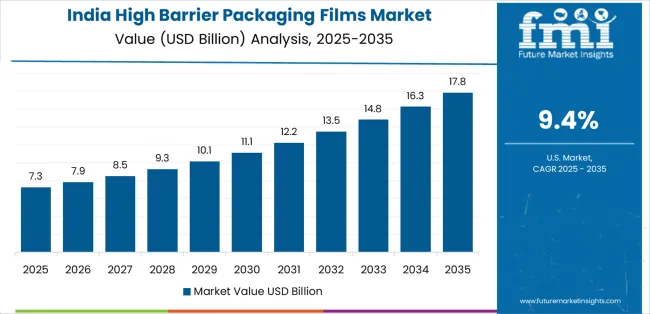
Revenue from high barrier packaging films in India is projected to exhibit exceptional growth with a CAGR of 9.4% through 2035, driven by expanding organized retail penetration and rapidly growing packaged food consumption supported by government initiatives promoting food processing development. The country's strong position in pharmaceutical manufacturing and increasing investment in cold chain infrastructure are creating substantial demand for barrier film solutions. Major food processors and pharmaceutical companies are establishing comprehensive packaging capabilities to serve both domestic consumption and export markets.
Demand for high barrier packaging films in China is growing at a CAGR of 8.3%, supported by the country's massive urban population, expanding convenience food market, and increasing adoption of flexible packaging solutions. The country's government initiatives promoting food safety and growing quality consciousness are driving requirements for sophisticated barrier packaging capabilities. International suppliers and domestic converters are establishing extensive production and converting capabilities to address the growing demand for barrier film products.
Revenue from high barrier packaging films in the USA is expanding at a CAGR of 6.5%, supported by the country's advanced material science capabilities, strong emphasis on packaging innovation, and robust demand for high-performance barrier solutions in food and pharmaceutical applications. The nation's mature converting sector and technology-focused operations are driving sophisticated barrier film development throughout the value chain. Leading manufacturers and technology providers are investing extensively in coating equipment and recyclable barrier structures to serve both domestic and international markets.
Demand for high barrier packaging films in Brazil is anticipated to grow at a CAGR of 7.9%, driven by the country's agricultural export sector, growing food processing industry, and increasing investment in packaging infrastructure. Brazil's position as a major food exporter and commitment to value-added processing are supporting demand for barrier film solutions across multiple agricultural segments. Manufacturers are establishing comprehensive converting capabilities to serve the growing domestic market and export opportunities.
Revenue from high barrier packaging films in Germany is expected to expand at a CAGR of 6.1%, supported by the country's packaging machinery leadership, advanced converting capabilities, and strategic focus on high-performance materials. Germany's engineering excellence and innovation culture are driving demand for barrier films in pharmaceutical blister packaging, technical applications, and premium food packaging. Manufacturers are investing in comprehensive R&D capabilities to serve both domestic brand owners and international specialty markets.
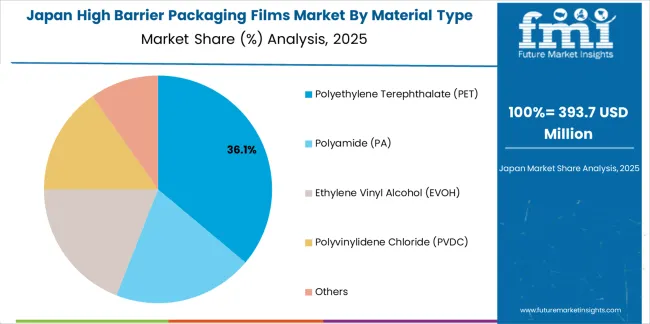
Demand for high barrier packaging films in Japan is growing at a CAGR of 5.6%, driven by the country's expertise in material science, emphasis on packaging quality, and strong position in convenience food packaging. Japan's established film manufacturing capabilities and commitment to continuous improvement are supporting investment in advanced barrier technologies throughout major industrial centers. Industry leaders are establishing comprehensive quality systems to serve domestic food manufacturers and pharmaceutical companies.
Revenue from high barrier packaging films in France is expanding at a CAGR of 6.4%, supported by the country's premium food manufacturing, strong pharmaceutical sector, and strategic position in European markets. France's culinary heritage and quality-focused culture are driving demand for high-performance barrier films in gourmet food packaging, cheese preservation, and wine packaging applications. Leading converters are investing in specialized capabilities to serve the stringent requirements of premium food and pharmaceutical industries.
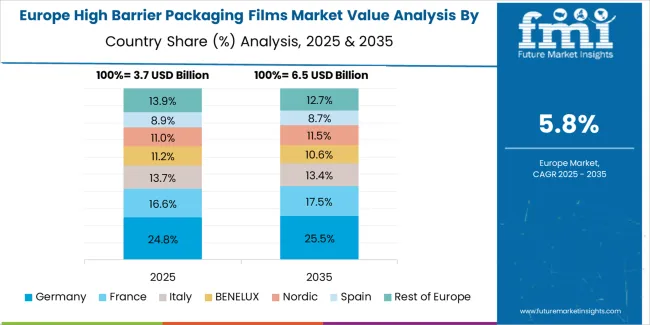
The high barrier packaging films market in Europe is projected to grow from USD 3.9 billion in 2025 to USD 7.7 billion by 2035, registering a CAGR of 7.0% over the forecast period. Germany is expected to maintain its leadership position with a 28.5% market share in 2025, declining slightly to 28.0% by 2035, supported by its strong converting industry, advanced coating technologies, and comprehensive packaging machinery sector serving diverse barrier film applications across Europe.
France follows with a 20.5% share in 2025, projected to reach 21.0% by 2035, driven by robust demand for barrier films in premium food packaging, pharmaceutical applications, and cheese preservation solutions, combined with established converting infrastructure and material innovation capabilities. The United Kingdom holds a 16.5% share in 2025, expected to reach 17.0% by 2035, supported by convenience food market growth and expanding ready meal sector. Italy commands a 14.5% share in 2025, projected to reach 14.8% by 2035, while Spain accounts for 9.5% in 2025, expected to reach 9.8% by 2035.
The Netherlands maintains a 5.0% share in 2025, growing to 5.2% by 2035. The Rest of Europe region, including Nordic countries, Eastern Europe, Switzerland, Austria, and other nations, is anticipated to maintain momentum, with its collective share moving from 5.5% to 4.2% by 2035, attributed to increasing food processing capabilities in Eastern Europe and growing pharmaceutical packaging demand in Switzerland implementing advanced barrier film programs.
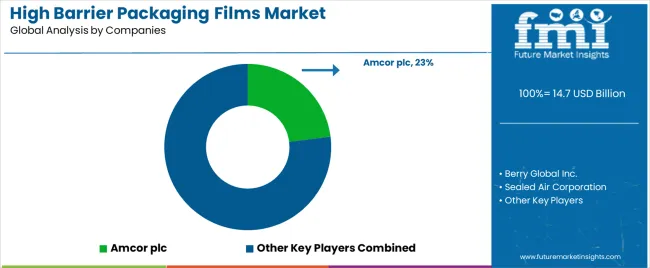
The high barrier packaging films market is characterized by competition among established film manufacturers, specialized coating companies, and integrated packaging solutions providers. Companies are investing in barrier coating research, multi-layer structure development, surface modification technologies, and comprehensive product portfolios to deliver consistent, high-performance, and application-specific barrier film solutions. Innovation in transparent barriers, recyclable structures, and smart packaging integration is central to strengthening market position and competitive advantage.
Amcor plc leads the market with a strong market share, offering comprehensive barrier film solutions with a focus on flexible packaging innovation and global converting capabilities. Berry Global Inc. provides extensive barrier film portfolios with an emphasis on technical films and customized structures. Sealed Air Corporation delivers innovative barrier solutions with a focus on food packaging applications and extended shelf life technologies. Constantia Flexibles specializes in pharmaceutical and food barrier films with advanced coating capabilities. Mondi Group focuses on paper-based barrier solutions and flexible film structures. Wipak Group offers specialized medical and food packaging films with emphasis on high-performance barriers.
| Item | Value |
|---|---|
| Quantitative Units (2025) | USD 14.7 billion |
| Material Type | Polyethylene Terephthalate (PET); Polyamide (PA); Ethylene Vinyl Alcohol (EVOH); Polyvinylidene Chloride (PVDC); Others |
| Barrier Layer | Metallized Films; Aluminum Oxide Coated; Silicon Oxide Coated; Organic Coated; Multi-Layer Structures |
| Application | Pouches & Bags; Lidding Films; Wrapping Films; Sachets; Others |
| Thickness | Below 50 Microns; 50–100 Microns; Above 100 Microns |
| End-Use | Food & Beverage; Pharmaceuticals & Healthcare; Personal Care & Cosmetics; Industrial; Others |
| Regions | North America; Europe; East Asia; South Asia & Pacific; Latin America; Middle East & Africa |
| Key Countries | United States, Canada, United Kingdom, Germany, France, China, Japan, South Korea, India, Brazil, Australia, and 40+ others |
| Key Companies | Amcor plc; Berry Global Inc.; Sealed Air Corporation; Constantia Flexibles; Mondi Group; Wipak Group |
| Additional Attributes | Dollar sales by material type & barrier layer; Regional demand trends; Competitive landscape; Advances in coating systems; Barrier performance development; Converting equipment innovation; Value-chain integration |
The global high barrier packaging films market is estimated to be valued at USD 14.7 billion in 2025.
The market size for the high barrier packaging films market is projected to reach USD 28.9 billion by 2035.
The high barrier packaging films market is expected to grow at a 7.0% CAGR between 2025 and 2035.
The key product types in high barrier packaging films market are polyethylene terephthalate (pet), polyamide (pa), ethylene vinyl alcohol (evoh), polyvinylidene chloride (pvdc) and others.
In terms of end-use industry, food & beverage segment to command 48.5% share in the high barrier packaging films market in 2025.






Full Research Suite comprises of:
Market outlook & trends analysis
Interviews & case studies
Strategic recommendations
Vendor profiles & capabilities analysis
5-year forecasts
8 regions and 60+ country-level data splits
Market segment data splits
12 months of continuous data updates
DELIVERED AS:
PDF EXCEL ONLINE
High Barrier Packaging Films for Pharmaceuticals Market Size and Share Forecast Outlook 2025 to 2035
Competitive Landscape of High Barrier Packaging Films for Pharmaceuticals
Market Share Breakdown of High Barrier Packaging Films Suppliers
High Barrier Pharmaceutical Packaging Films for Blister Market Size and Share Forecast Outlook 2025 to 2035
High Performance Fluoropolymer Market Size and Share Forecast Outlook 2025 to 2035
High Throughput Screening Market Size and Share Forecast Outlook 2025 to 2035
High Mast Lighting Market Size and Share Forecast Outlook 2025 to 2035
High-Protein Pudding Market Size and Share Forecast Outlook 2025 to 2035
High Purity Carbonyl Iron Powder (CIP) Market Size and Share Forecast Outlook 2025 to 2035
High Voltage PTC Heater Market Size and Share Forecast Outlook 2025 to 2035
High-Performance Fiber Market Size and Share Forecast Outlook 2025 to 2035
High Temperature Grease Market Size and Share Forecast Outlook 2025 to 2035
High Frequency Chest-Wall Oscillation Devices Market Size and Share Forecast Outlook 2025 to 2035
High-purity Fluoropolymer Valves Market Size and Share Forecast Outlook 2025 to 2035
High Current Ion Implanter Market Size and Share Forecast Outlook 2025 to 2035
High Rate Discharge Test Machine Market Size and Share Forecast Outlook 2025 to 2035
High-precision Confocal Sensor Market Size and Share Forecast Outlook 2025 to 2035
High Performance Carbon Fiber Precursor Market Size and Share Forecast Outlook 2025 to 2035
High Voltage Distribution Substation Market Size and Share Forecast Outlook 2025 to 2035
High-power Objective Lens Market Size and Share Forecast Outlook 2025 to 2035

Thank you!
You will receive an email from our Business Development Manager. Please be sure to check your SPAM/JUNK folder too.
Chat With
MaRIA